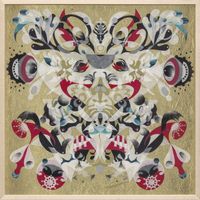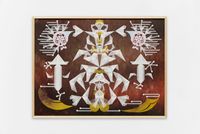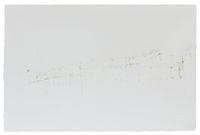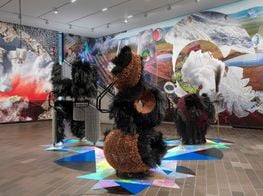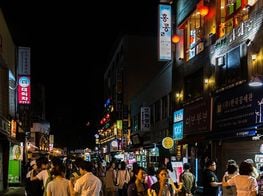Haegue Yang (Part One)

Haegue Yang is a South Korean artist, who lives and works in Berlin and Seoul. She is best known for drawing on a wide repertoire of ordinary household objects to create visually abstract sculpture and installations that delve into a cacophony of social, historical and political narratives.
In 2004, she famously exhibited a pallet pack of her unsold work, creating what Marina Vishmidt commented on as 'an allegory for a whole history of "de-materialization" in art, and a reflection on the misunderstanding of materiality so crucial to that history. A German collector purchased the work and it has since had various iterations, most importantly at Los Angeles County Museum of Art, when in 2009, it was "unpacked" transforming the work into a type of performance.
In 2006, Yang began using venetian blinds in her work, and when she represented South Korea in the 53rd Venice Biennale, blinds were the main motif along with fans in an installation that evoked an awareness of light, shadow, smell and even humidity. In 2012, the artist participated in dOCUMENTA13 with the work, Approaching — Choreography Engineered in Never-Past Tense (2012), a vast installation presented in the main train station in Kassel.
A kinetic sculpture, the work featured venetian blinds supended from the ceiling that folded up and down in a two-hour long choreography of mechanical sound and movement addressing ideas of modernisation and industrialisation and their impact on different continents. Most recently the work Accommodating the Epic Dispersion — On Non-cathartic Volume of Dispersion, which consists of a vast tower of layered blinds was displayed in the Unlimited Sector at Art Basel 2014.
The work was previously commissioned for Haus der Kunst's vast middle hall, and like much of Yang's work examines the figures and events that seem significant to what the artist describes as the "as yet unfolded complexities" involved with the experience of migration and diaspora.
While the blinds are the most recognisable motif in Yang's work, they sometimes obscure the range of her artistic explorations which have continued to evolve. Two presentations this year will serve as timely reminders of the scope and ongoing development of her practice: Medicine Men and Female Natives (2010) at the Taipei Biennial and the ensemble of so-called 'Sonic Sculptures' for Mediacity in Seoul.
In this two part interview, which traces certain aspects of the artist's career from 2001 to today, Yang discusses inspiration for her work, the underlying ideas that inform it, works that will appear at the Taipei Biennial and Mediacity Seoul, and the challenges she still wishes to explore.
ADBEGINNING, INFLUENCES AND EARLY WORK
When did you decide to become an artist?
HYThis decision was made so long ago and therefore it feels kind of insignificant to mention now. However, I first wished to become an artist when I was in kindergarten. Since then, my understanding of the notion of 'artist' has evolved. At 6 years old, an artist was a painter who could draw the best camel; at Junior High, I saw an artist as someone who could paint or draw the best still life or Greek or Roman statue; on entering college, I discovered sculpture and various art forms.
I guess the decision to become an artist is less meaningful than the evolutionary process of understanding what it means to be an artist. My understanding of this is still evolving, and experiencing and recognizing the role, abilities, capacities, as well as the limitations of being an artist is significant for continuous growth to respond to internal and external challenges. In other words, I am still in the process of becoming one.
ADIn one of your early works, Traces of Anonymous Pupil Authors (2001), you deleted the printed text in used Korean school-books leaving nothing but the numerous markings made by pupils — underlines, circles, and so on. Can we discuss this early work and what you were exploring when you created it?
HYThe 16 offset prints of Traces of Anonymous Pupil Authors was one of numerous attempts in my formative years that demonstrate how I tried to approach texts, or notions of text/writing/translating. As Traces of Anonymous Pupil Authors shows, the texts could be understood as a given structure, reflecting somewhat repressive and conventional structures of education in a nation/state system, which individuals are forced to relate to, and fit in with.
The markings and drawings of the pupils-authors are clear and direct, yet unconscious, expressions of these young peoples' struggle with/against the knowledge system imposed on them. Another aspect of my methodology of working during my formative years was focused on minimizing my own artistic hegemony to emphasize 'other/real authors'. I guess I was rather concerned with efforts to activate other peoples, often anonymous, voices rather than my personal one. Around 2004, these attempts to activate the notion of voice from text based material developed further, when it evolved into the use of real voices when I started to work on narrations in so-called 'video-essays'.
ADQuasi MB — In the Middle of its Story (2006/2007) involves the display of texts you wrote in the rain, and it was intended to evoke Broodthaers film, La Pluie (1969). Can we discuss this work and how it related to Broodthaers?
HYQuasi MB — In the Middle of its Story is a work with 18 pieces of drawings, or rather, writings. These were the outcome of an attempt to both put myself in the position of Marcel Broodthaers, while simultaneously juxtaposing myself next to a figure like him — a male, western, avant-garde conceptual artist. As we know, in his film, La Pluie, the artist demonstrates the notion of writing in a slapstick-like setting, where his intention to write is complicated by a shower of water from above.
In comparison, for my work, I created the drawings and writings literally under the rain and without any camera in front of me. Being alone, without a spectator and the need to perform in front of a camera was one way in which the 'real' situation was reintroduced in place of Broodthaers' staged scene.
Also, the physicality of the proof of the action, the written papers, was reconstructed in place of the lost writing. The replacement of film documentation with writing could be seen as rather nostalgic or even counter-conceptual. However, my fundamental interest was how I could represent my generation of diaspora artists whose studies were informed by western art history/tradition, but equally post-colonial and post-structural ways of thinking that resisted dominant and hegemonic history-writing.
ADSTORAGE PIECE
In 2004, you exhibited the work Storage Piece, which featured a collection of earlier works stored in shipping containers that were wrapped together on several transport pallets. Since you first showed this work, and even following its sale to a private collector, it has had many iterations. Can you discuss the evolution of this work?
HYThe work initially evolved from my duel dilemma of having to respond to an exhibition invitation, while also having to find storage space for old works. The works that I could not store, and which I felt ambivalent about showing in any case, were professionally packaged and shipped off to the gallery to be shown in that condition — old works became a new work and the exhibition space became a storage space.
This piece has been a turning point in many ways. The personal and individual circumstances surrounding Storage Pieces' original creation, as well as the work's entire ecology (creation, exhibition display, storage and market) have become inseparable from its conceptual framework. The interrelationship between the personal and the conceptual are articulated through this piece - but its ultimate complexity is not something I could have achieved just by making it.
When making the work I began with my interest in how colonial history affects and transforms us.
ADIn relation to Storage Piece, I am interested in its iteration as part of the exhibition at Los Angeles County Museum of Art, Your Bright Future, in 2009, where it was unpacked over the course of the exhibition to reveal the artworks it contained. Can we discuss how this extended the original work?
HYI quote Marina Vishmidt in relation to this question:
"(....) and these transformations went further still: The new work, if purchased, could be maintained as a new work and an old work at the same time, if it was unpacked into its components (a process to be negotiated between the artist and collector). Thus the 're-statement' of old work into new work also started to look like a discount offering, a bulk buy, lampooning the prestige of its exhibition situation while taking advantage of it. (...) Yang displays a 'conflicting situation', bringing out the implicit into debate.
Does the artist show work because she has nowhere else to put it, and she is hoping it will sell? Is it necessary to present autonomous art objects in a gallery space to have a show; need the works be unwrapped, to adapt one of Sol LeWitt's axioms ('the work need not be made')? (...) It could almost be considered an allegory for a whole history of 'de-materialization' in art, and a reflection on the misunderstanding of materiality so crucial to that history."
As Marina mentions,Storage Piece somehow represents an entire catalogue of questions I wished to pose, both to myself as well as to share with others. The ongoing 're-statement' ever since the piece was sold, proves that the piece continues its life in an adventurous way - constantly re-examining the notion of the object in art. Instead of simply occupying space and being a visual expression, an object has the potential to provoke various questions.
ADVENETIAN BLIND AS MOTIF
The use of store-bought venetian blinds is very much a signature motif of your work. I believe you first started using the blinds in 2006, when you created Series of Vulnerable Arrangements — Blind Room — a piece that was originally created for the 2006 São Paulo Biennale and re-created in 2007 for the group exhibition Brave New Worlds at the Walker Art Center. Was there a specific moment that led you to use the venetian blind?
HYI discovered the material of Venetian blinds step by step, by conceiving and realizing different pieces, such as Blind Room (2006), Mountains of Encounter (2008),Lethal Love (2008), Three Kinds (2008), Yearning Melancholy Red (2008), Series of Vulnerable Arrangements — Shadowless Voice over Three (2008), Cittadella (2011), etc. Specifically 2008 was a year of intense experimentation with this material, which arose in the context of contemplating the notion of barriers gradually unfolding.
Julienne Lorz in her essay on my recent work perhaps best narrates the role of the blind as primary material:
"To grasp Accommodating the Epic Dispersion — On Non-cathartic Volume of Dispersion in its entirety is unachievable, since a single standpoint does not exist and each angle of approach affords ever changing points of view. The blinds appear variously opaque, semi-opaque or completely transparent and even almost invisible in places.
This is further enhanced by the strict lighting concept and the colors that flow from one complementary hue to another, demonstrating the entire available color palette of the industrially manufactured, yet customized blinds. These elements of light, color, and changing angles invite the viewer to physically negotiate the space".
ADHaus der Kunst, Munich, originally commissioned Accommodating the Epic Dispersion (2012) for its expansive Middle Hall. Can we please discuss some of the ideas underlying this work?
HYWhen making the work I began with my interest in how colonial history affects and transforms us. Even if colonization takes shape differently now than in the past, it's quite present in the stream of power around us — ranging from European fascism at the time of World War II to contemporary colonial phenomena disguised in various economic forms. It seems to me that the legacy of colonialism has never really ceased to maintain its impact on us.
People migrate and disperse constantly for survival, fleeing from violence or danger, or for a better life, instead of getting settled in a community. Most of the positive ideas associated with settlement or building a community seem either to fail or deceive, while most of what constitutes real politics falls short of paying attention to the counter-narratives in these migrations and exiles.
In other words, the non-conformist movements that cross the border and go against the conventional nation-state are only traced in order to be controlled and suppressed, rather than being observed and understood.
I am interested in examining the figures and events that seem significant to comprehend the elusive aspects of the colonial circumstances in which we are living today. For me, the challenge I faced at Haus der Kunst responded to my desire to overcome the simplicity of dichotomies, to get closer to the as-yet unfolded complexities in the colonial dispersion and migration ranging from physical exodus to mental break-down.
ADHow do these ideas relate to the title of the work - Accommodating the Epic Dispersion — On Non-cathartic Volume of Dispersion?
HYI felt the long title corresponded strangely well to the volume of the air encountered when looking up at the ceiling of Haus der Kunst through the layers of the Venetian blinds. I also intended the title to resonate with the topics of migration, displacement, postcolonial diaspora, forced exile, and so on.
The word dispersion is repeated twice in the title, which is significant. Dispersion does not necessarily have a positive connotation, compared with 'unity' and 'consensus,' even though I believe that the word describes a common phenomenon of our time when so many people travel, immigrate, and for varied reasons, many couples and family members live apart from each other.
I wanted to treat this phenomenon in a non-judgmental way, despite the fact that both historically and currently, the separation from the homeland has been and is frequently caused by injustice. I wanted to open up a discussion by drawing attention to the wide, broad, and multilayered images of dispersion that surround us, and raise questions about how community is assembled and dissolved according to the movement of people.
In observing such phenomena, the tendency is to try and find a resolution, because we see the problems in them. The word 'non-cathartic' suggests a less solution-oriented, less problematizing perspective. I wanted to consider the relevant issues deeply and to fully contemplate and digest them by dwelling in them. I pictured the space of Haus der Kunst accommodating a structure of dispersion, a kind of three-dimensional map of dispersion, and I invited others to view and contemplate it also.
To me, a contemporary artist chooses a vocabulary to understand and articulate the politics of language...
ADEpic Dispersion was created around the same time that you made Approaching — Choreography Engineered in Never-Past Tense (2012), a vast installation presented in the main train station of Kassel for dOCUMENTA (13). This work is kinetic and the blinds move up and down. How is movement important to your practice?
HYFor this particular piece, black, ceiling-high aluminum blinds pursued a life of their own through automated up-and-down, opening-and-closing movements. With a former railway cargo station as its site, the two-hour long choreography was a way of addressing ideas of modernisation and industrialisation. Together with the kinetic element, the aural and visual aspects of the work were intended to unnerve viewers - an echo of the unsettling history of industrialization occurring at different times in different continents.
I do have a longstanding interest in movement in all its nuances — physical, social and spiritual as well as emotional. I elaborated on this in_Accommodating the Epic Dispersion — On Non-cathartic Volume of Dispersion_, but within the context of migration, historical and postcolonial diasporas and enforced exile. It was an initial, but also ambitious attempt, to map historical figures of diaspora onto the architectural history of fascism in order to overlap our separate perspectives on globalised, ethnic and historical migrations. T
here are similarities, but also differences — for instance between the way Jewish people were demonized and expelled, and the so-called labor-related immigration in our globalised society. While the deliberately lengthy title was in response to the vast hall where the work was located, it linguistically also alludes to the community and the epic nature of migratory biographies that informed my research, for instance Korean-Japanese essayist Suh Kyungsik's research on Italian-Jewish author and Holocaust survivor Primo Levi, that were complex, trans-continental and trans-generational.
ADIs it important to you that your audience is aware of these references?
HYMy driving interests and motivations are often concrete, but my artistic language is one of abstraction. Abstraction is, for me, a way of thinking and working through collective and individual narratives across different histories, generations and locations. They coincide and overlap, becoming comprehensible on a personal level in linguistically unexplainable ways. As artists, we have aesthetic tools, each with its particular language, to provide a distinctive form of experience.
To me, a contemporary artist chooses a vocabulary to understand and articulate the politics of language and how these dominant politics address, constitute and reproduce injustices. For example, the blind constellations in Accommodating the Epic Dispersion — On Non-cathartic Volume of Dispersion obstruct and activate one's view.
Circulating around the installation becomes an experience of 'blind' or 'silent' communication, a negation of acquired knowledge and the opening of a new space, a position of uncertainty that enables a discovery and a shift in perspective. I see this as maneuvering the rules of experience, and it has become an important aspect of my blind installations. — [O]
Read: Haegue Yang - Part II
Haegue Yang on Show
Ghosts. Spies and Grandmothers - SeMA Biennale Mediacity Seoul 2014, Seoul, Korea
September 2 - November 23 2014
http://mediacityseoul.kr/teaser/#theme–
The Great Acceleration - Taipei Biennial 2014, Taipei, Taiwan
September 13 - January 2015
http://www.biennialfoundation.org/biennials/taipei-biennial/–
Follies, mehrfach: Gabriel Lester - Haegue Yang / Follies, manifold: Gabriel Lester - Haegue Yang, Bonner Kunstverein, Bonn, Germany
September 23 - November 23 2014
http://www.bonner-kunstverein.de/ausstellungen/vorschau/



